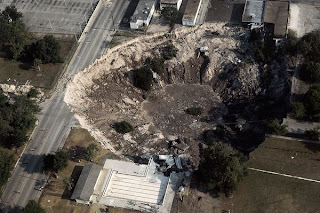A Pit reminds us of Hell…isn’t it? Deep, dark and scary sinkholes that could eat us alive anytime even occur on any day. A Sinkhole is a natural depression or hole in the Earth’s surface caused by Karst Processes or the chemical dissolution of carbonate rocks or suffusion processes for example in sandstones. Sinkholes may be formed gradually or suddenly, and are found worldwide. The pictures below are the famous sinkholes worldwide.
Guatemala Sinkhole 2010
This sinkhole was triggered by the tropical storm Agatha that hit the city of Guatemala in May of 2010. This said to be be a man made sinkhole due to the piping features. The underground infrastructure were built in a region where the first few hundred meters of ground are mostly made up of a material called pumice fill which was deposited during past volcanic eruptions .The sinkhole has swallowed a huge building but no victims was reported.
Guatemala Sinkhole 2007
This sinkhole appeared not far from the 2010 sinkhole in the said city in 2007. This hole is said to be as deep as the sinkhole in 2010 of about 60 feet wide and 300 feet deep.
Winter Park, Florida Sinkhole
The sinkhole in this city opened up in 1981 underneath the city’s swimming pool. The occurrence could have been a leakage from the pool. The water can flow into the underlying soil through cracks in the bottom of the pool. Even watering plants could have added enough runoff through Florida’s sandy soil to erode solid limestone underneath.
Blue Hole, Belize
Sinkholes can happen anywhere, where water can erode a vertical channel that connects to a horizontal drain, a situation that allows a column of solid material to wash away. If the sinkhole is near the sea—or in the sea, as with the famous Blue Hole in Lighthouse Reef off the coast of Belize—seawater can quickly seep in after a collapse, forming a deep pool.
Picher, Oklahoma, Sinkhole
Long term of mining for zinc made this sinkhole in this particular place in Oklahoma in 2008.Some mines were dug too close to the surface, and the roofs were unable to support the weight of earth on top, leading to collapses.
Iceland Sinkhole
This is a photo of adventure kayaker Mick Coyne while he lowers himself down the wall of this famous sinkhole in Jokulsa,Iceland. This inverted funnel-shaped hole was created by rising steam from geothermal vents below the river. This hole is said to be 150 feet or 45 meters deep.
Ik-Kil Cenote, Mexico
Swimmers floating in the saphire waters of Ik-Kil cenote, near the famous Mayan site in Mexico's Yucatan Peninsula. Cenote means "natural well" in spanish. Sinkholes at sea level will fill up as high as the water's surface, creating the famous clear blue pools. This pool is said to have been used by the Mayan royalties for both relaxation and ritual sacrifices.
Lisbon, Portugal, Sinkhole
An unfortunate bus has been the meal of this sinkhole in the city of Lisbon in Portugal while the bus was parked where the sinkhole opened up in 2003. Anything that increases the flow of water in to the subsurface of soil can speed up the formation of any sinkholes.
Neversink Pit, Alabama
This sinkhole was discovered in 1998. It is about 50 feet deep and shelters rare species of ferns. The sinkhole was bought in the 1990's by a group of cavers to preserve it for future generations. Neversink pit is a wet limestone sinkhole which is actually formed due to the Karst process mainly by dissolving of limestone or dolomite bedrock.









You can't read this with your background...
ReplyDelete